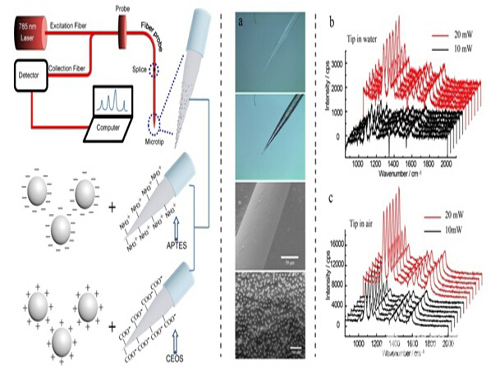
Recently, the team member Meng Guowen of the Institute of Solid State Physics, Chinese Academy of Sciences, Hefei Institute of Physical Physics, and the Mao Qinghe Research Group, a researcher at the Institute of Optics and Fine Mechanics of Anhui Province, cooperated with a fiber-optic probe with surface-enhanced Raman scattering (SERS) activity. Research made new progress. Based on the principle of electrostatic adsorption, the research team developed a universal assembly method that assembled a variety of charged metal nanostructures with plasmon properties onto the surface of a tapered fiber probe. The structure can be used as a SERS fiber probe, which is of great significance for remote and portable on-line detection of pollutants. The relevant results are published in ACS Appl. Mater. Interfaces 2015, 7, 17247?17254.
The development of optical fiber communication technology opens up new ways for high-throughput, remote real-time SERS detection of pollutants. The core idea is to couple high-SERS-active nanostructures to the surface of fiber-optic probes and integrate them into portable fiber Raman spectrometers. By collecting and detecting the SERS signal of pollutants, the portable rapid detection of pollutants can be achieved. To achieve this goal, researchers have developed methods such as pull coating, photochemical deposition, or physical vapor deposition to deposit noble metal nanostructures onto fiber probes. However, the SERS fiber probes prepared by these research methods have certain limitations in function. For example, for the pull coating method, SERS-active nanostructures have weak adhesion on the surface of the optical fiber and are easily diffused in liquid samples, thereby affecting the stability of the detection signal; for physical vapor deposition and laser-induced photochemical deposition methods, due to Due to the limitation of the preparation process, it is difficult to precisely regulate the morphology and size of the nanostructure, and the local electromagnetic field enhancement and surface plasmon resonance characteristics cannot be optimized, and the sensitivity of the SERS detection of contaminants cannot be guaranteed.
In response to the above problems, Meng Guowen's research group cooperated with Mao Qinghe's research group to use an electrostatic assembly method (as shown in the following figure) to assemble noble metal nanostructures with positive/negative properties onto the surface of a tapered optical fiber modified with a silane coupling agent. An efficient SERS fiber probe. First, in the process of constructing nanostructures with controllable morphology based on the liquid phase method, the surfactants used can make the nanostructures exhibit controlled surface physicochemical properties, such as positive/negative electricity, hydrophilicity/hydrophobicity, etc. . Secondly, the main component of the optical fiber is silicon oxide, and there are a large number of hydroxyl groups on the surface, which is easy to couple with a silane coupling agent through the formation of Si-O-Si bonds; at the same time, the silane coupling agent has a functional group at the end, so that the entire optical fiber is rich in specific functionality. Therefore, for negatively charged nanostructures (such as citrate-protected gold nanospheres), amino-containing silane coupling agents are selected to modify the fibers; conversely, for positively charged nanostructures (such as CTAB-protected gold nanorods), The use of a carboxyl-terminated silane coupling agent to modify the optical fiber enables efficient assembly of noble metal nanostructures on the surface of the optical fiber. For example, a variety of SERS active nanostructures (gold nanospheres, gold nanorods, gold@silver core shell nanorods, and cubic silver) with different morphology and optical properties can be controllably assembled onto the surface of the optical fiber. This SERS fiber probe has high stability (relative signal deviation less than 3%), many types of fiber (for single-mode, multi-mode, D-type, micro-nano fiber, etc.) and high sensitivity. The parathion-based sensitivity reaches 10 nanomolar. Relevant results have been applied for national invention patents and published in ACS Appl. Mater. Interfaces magazine.
The above research was funded by the National Science and Technology Department's "973" program and the National Natural Science Foundation.
Air Pump,Car Air Tire Inflator,Car Tire Air Pump,Smart Tire Inflator
Shenzhen High Railway Technology Co., Ltd , https://www.hrw-tech.com